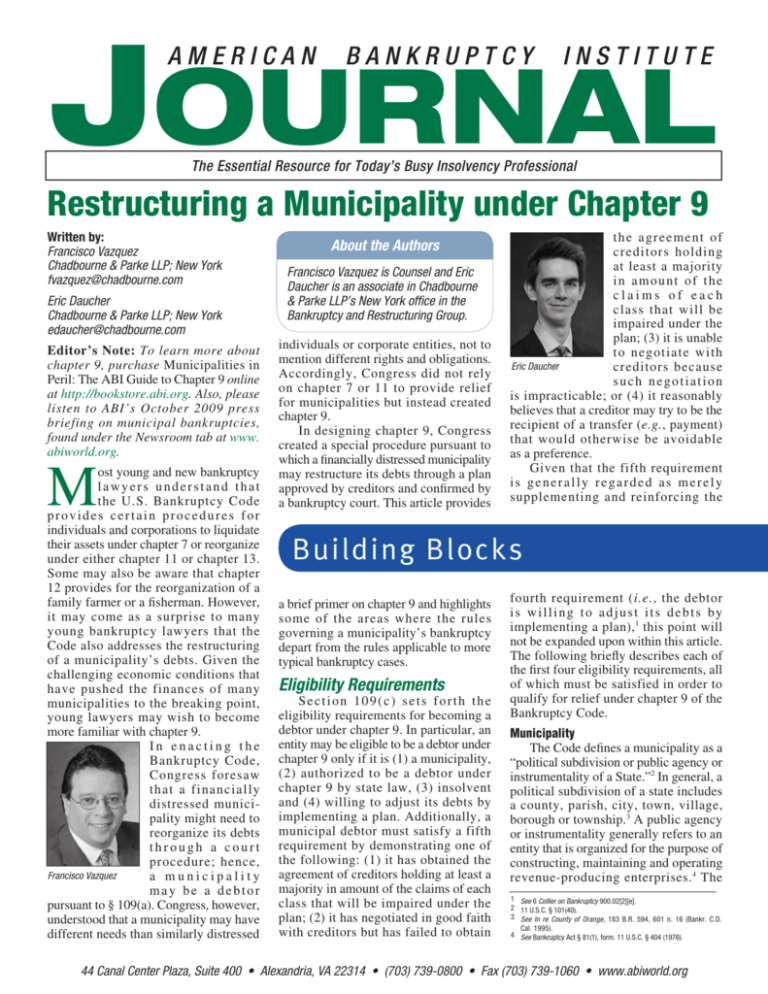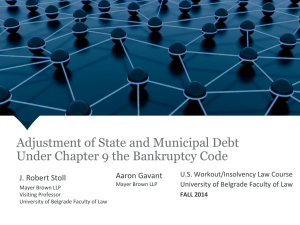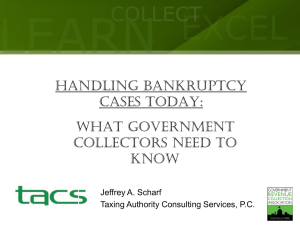Restructuring a Municipality under Chapter 9
advertisement

Journal AMERICAN BANKRUPTCY INSTITUTE The Essential Resource for Today’s Busy Insolvency Professional Restructuring a Municipality under Chapter 9 Written by: Francisco Vazquez Chadbourne & Parke LLP; New York fvazquez@chadbourne.com Eric Daucher Chadbourne & Parke LLP; New York edaucher@chadbourne.com Editor’s Note: To learn more about chapter 9, purchase Municipalities in Peril: The ABI Guide to Chapter 9 online at http://bookstore.abi.org. Also, please listen to ABI’s October 2009 press briefing on municipal bankruptcies, found under the Newsroom tab at www. abiworld.org. M ost young and new bankruptcy lawyers understand that the U.S. Bankruptcy Code provides certain procedures for individuals and corporations to liquidate their assets under chapter 7 or reorganize under either chapter 11 or chapter 13. Some may also be aware that chapter 12 provides for the reorganization of a family farmer or a fisherman. However, it may come as a surprise to many young bankruptcy lawyers that the Code also addresses the restructuring of a municipality’s debts. Given the challenging economic conditions that have pushed the finances of many municipalities to the breaking point, young lawyers may wish to become more familiar with chapter 9. In enacting the Bankruptcy Code, Congress foresaw that a financially distressed municipality might need to reorganize its debts through a court procedure; hence, Francisco Vazquez a municipality may be a debtor pursuant to § 109(a). Congress, however, understood that a municipality may have different needs than similarly distressed About the Authors Francisco Vazquez is Counsel and Eric Daucher is an associate in Chadbourne & Parke LLP’s New York office in the Bankruptcy and Restructuring Group. individuals or corporate entities, not to mention different rights and obligations. Accordingly, Congress did not rely on chapter 7 or 11 to provide relief for municipalities but instead created chapter 9. In designing chapter 9, Congress created a special procedure pursuant to which a financially distressed municipality may restructure its debts through a plan approved by creditors and confirmed by a bankruptcy court. This article provides the agreement of creditors holding at least a majority in amount of the claims of each class that will be impaired under the plan; (3) it is unable to negotiate with Eric Daucher creditors because such negotiation is impracticable; or (4) it reasonably believes that a creditor may try to be the recipient of a transfer (e.g., payment) that would otherwise be avoidable as a preference. Given that the fifth requirement is generally regarded as merely supplementing and reinforcing the Building Blocks a brief primer on chapter 9 and highlights some of the areas where the rules governing a municipality’s bankruptcy depart from the rules applicable to more typical bankruptcy cases. Eligibility Requirements Section 109(c) sets forth the eligibility requirements for becoming a debtor under chapter 9. In particular, an entity may be eligible to be a debtor under chapter 9 only if it is (1) a municipality, (2) authorized to be a debtor under chapter 9 by state law, (3) insolvent and (4) willing to adjust its debts by implementing a plan. Additionally, a municipal debtor must satisfy a fifth requirement by demonstrating one of the following: (1) it has obtained the agreement of creditors holding at least a majority in amount of the claims of each class that will be impaired under the plan; (2) it has negotiated in good faith with creditors but has failed to obtain fourth requirement (i.e., the debtor is willing to adjust its debts by implementing a plan), 1 this point will not be expanded upon within this article. The following briefly describes each of the first four eligibility requirements, all of which must be satisfied in order to qualify for relief under chapter 9 of the Bankruptcy Code. Municipality The Code defines a municipality as a “political subdivision or public agency or instrumentality of a State.”2 In general, a political subdivision of a state includes a county, parish, city, town, village, borough or township.3 A public agency or instrumentality generally refers to an entity that is organized for the purpose of constructing, maintaining and operating revenue-producing enterprises. 4 The 1 See 6 Collier on Bankruptcy 900.02[2][e]. 2 11 U.S.C. § 101(40). 3 See In re County of Orange, 183 B.R. 594, 601 n. 16 (Bankr. C.D. Cal. 1995). 4 See Bankruptcy Act § 81(1), form. 11 U.S.C. § 404 (1976). 44 Canal Center Plaza, Suite 400 • Alexandria, VA 22314 • (703) 739-0800 • Fax (703) 739-1060 • www.abiworld.org source of the revenue may be taxes, assessments or income-producing property. 5 School districts, hospital districts, highway authorities and gas authorities are examples of public agencies or instrumentalities.6 Authority to Be a Debtor In order to be eligible for relief under chapter 9, a municipality must be specifically authorized to file for bankruptcy by its state. Such authorization may come from either state law or any authority appropriately empowered by state law.7 Approximately half of the states explicitly allow their municipalities to become chapter 9 debtors, while the remainder either offer little guidance or explicitly ban access to bankruptcy relief. Certain states, such as California, are currently contemplating legislation that would sharply curtail access to chapter 9.8 Insolvent Section 101 defines “insolvent” differently based upon the nature of the relevant entity.9 Under the Bankruptcy Code, a municipality is “insolvent,” if it is: 1. generally not paying its debts as they become due, unless such debts are the subject of a bona fide dispute; or 2. unable to pay its debts as they become due.10 Under the first formulation, a court would rely on evidence that the municipality is not paying its debts rather than on budgets that reflect a cash flow shortfall. 11 In general, nonpayment of undisputed amounts that a municipality can pay, nonpayment of debts that are not due or nonpayment in bad faith will not satisfy the first formulation. The second formulation requires a prospective analysis. 12 A municipality may attempt to demonstrate insolvency under the second prong by preparing a budget.13 A court will ultimately evaluate 5 6 7 8 See id. See id. 11 U.S.C. § 109(c)(2). Since the financial crisis of 2008, California has become the epicenter of likely chapter 9 filings. On April 19, 2010, California’s Senate Local Government Committee advanced Assembly Bill 155, which would require municipalities to satisfy a number of requirements, in addition to those imposed by chapter 9 before becoming a debtor. For example, a California municipality would be barred from filing under chapter 9 without first obtaining approval from the California Debt and Investment Advisory Commission. In order to obtain such approval, a municipality would be required to, among other things, demonstrate that it has exhausted all options to avoid seeking relief under chapter 9. Ultimately, this provision could prove problematic given that most municipalities could theoretically avoid filing for chapter 9 by immediately increasing or levying taxes. As of the date of this article, Assembly Bill 155 had not been enacted. 9 See 11 U.S.C. § 101(32). 10 11 U.S.C. § 101(32)(C). 11 See In re Town of Westlake, Texas, 211 B.R. 860, 864 (Bankr. N.D. Tex. 1997). 12 See In re Hamilton Creek Metropolitan Dist., 143 F.3d 1381, 1385 (10th Cir. 1998). 13 See In re City of Bridgeport, 129 B.R. 332, 338 (Bankr. D. Conn. 1991). the evidence in determining whether the entity is eligible for relief under chapter 9 or whether a plan of adjustment, discussed in greater detail below, should be approved. Under both formulations, insolvency should be determined as of the date of the bankruptcy filing.14 Willingness to Adjust Debts Only a municipality that “desires to effect a plan to adjust [its] debts” is eligible for relief under chapter 9.15 The purpose of this requirement is to ensure that the municipal debtor is not simply trying to delay or frustrate its creditors, but rather is willing to propose a plan of adjustment.16 The Chapter 9 Petition Assuming that a municipality can satisfy the requirements discussed above, it will be eligible to commence a bankruptcy case under chapter 9. Like other bankruptcy cases, a chapter 9 case is commenced by the filing of a bankruptcy petition. Upon the filing of a petition for relief under chapter 9, an “automatic stay” comes into effect. The automatic stay in a chapter 9 case is similar to the automatic stay in other bankruptcy cases in that it enjoins the commencement or continuation of most formal and informal actions for the collection of claims or enforcement of liens against the debtor or property of the debtor’s estate. However, in a municipal bankruptcy case, the automatic stay is expanded to enjoin (1) actions against employees or residents of the municipality that seek to enforce claims against the debtor and (2) the enforcement by creditors of a lien that arises from taxes or assessments owed to the debtor.17 The Plan of Adjustment The culmination of a chapter 9 case is the confirmation of a “plan of adjustment,” which provides for the restructuring of the municipal debtor’s debts and is the chapter 9 equivalent of a chapter 11 “plan of reorganization.” Holders of impaired claims are entitled to vote to accept or reject plan. In essence, a claim is impaired under a chapter 9 if the legal, equitable or contractual rights of the holder of such claim will be altered in any way (e.g., maturity will be extended), just as under a chapter 11 plan.18 If the requisite votes are received 14 See In re Slocum Lake Drainage Dist. of Lake Cty., 336 B.R. 387, 391 (Bankr. N.D. Ill. 2006). 15 11 U.S.C. § 109(c)(4). 16 See Collier on Bankruptcy, ¶ 900.02[2][d] (15th ed., revised, 2009). 17 See 11 U.S.C. § 922(a). 18 See 11 U.S.C. § 1124 (made applicable in chapter 9 proceedings by 11 U.S.C. § 901(a)). in favor of the plan and all other Code requirements are satisfied, the plan must be confirmed by the court.19 A confirmed plan is binding on all creditors, including those that voted to reject the plan.20 Under chapter 9, only the municipal debtor may propose a plan of adjustment. 21 Although the plan of adjustment is typically filed with the petition, it may be filed at a later time as the court directs. There is no statutory deadline for the filing of a plan of adjustment under chapter 9. Thus, a municipality’s creditors cannot pressure it by seeking to terminate exclusivity.22 Nevertheless, a municipality should generally be motivated to file a plan of adjustment as soon as possible to address obvious political concerns. A plan of adjustment must be confirmed under chapter 9 if all of the following seven conditions are satisfied: 1. the debtor complies with all of the provisions of the Bankruptcy Code made applicable to a chapter 9 case (e.g., provisions addressing disclosure and solicitation requirements, classification and treatment of claims, good faith requirement); 2. the debtor complies with all of the requirements of chapter 9; 3. all amounts to be paid by the debtor for services or expenses in the case or incident to the plan are disclosed and are reasonable; 4. the debtor is not prohibited by law from taking any action necessary to implement the plan; 5. the plan provides for payment in full of all administrative expense claims, unless the holder of such claims agrees to different treatment; 6. all regulatory or electoral approval for any action to be taken under the plan has been obtained; and 7. the plan is in the best interest of creditors and is feasible.23 Chapter 9 also borrows a number of confirmation criteria from chapter 11. For example, a plan of adjustment can only be confirmed if it complies with the Code sections governing classification of claims. In particular, § 1122 of the Code provides that “substantially similar” claims can be placed in the same class. The requirement of substantial similarity does not mean, however, that claims or interests within a particular class must be 19 11 U.S.C. § 943(b). 20 See 11 U.S.C. §§ 901(a), 1126(c). 21 See 11 U.S.C. § 941. 22 See 11 U.S.C. § 941. 23 11 U.S.C. § 943. 44 Canal Center Plaza, Suite 400 • Alexandria, VA 22314 • (703) 739-0800 • Fax (703) 739-1060 • www.abiworld.org identical. A municipal debtor would have flexibility in classifying claims. In general, a plan of adjustment, like a plan of reorganization, may only be confirmed if all classes of creditors vote in favor of the plan.24 A class of claims accepts a plan “if such plan has been accepted by creditors...that hold at least two-thirds in amount and more than onehalf in number of the allowed claims voting in such class.”25 Nevertheless, a plan may be confirmed over the vote of a dissenting class of creditors. A bankruptcy court may “cram down” a plan over the dissent of an impaired class or classes as long as the plan does not “discriminate unfairly” and is “fair and equitable” with respect to the dissenting classes.26 Upon confirmation, the municipal debtor and all of its creditors are bound by the terms of the plan of adjustment.27 Further, the debtor is discharged of all debts, except those retained under the plan and those owed to creditors who had no prior notice or actual knowledge of the case. Unlike chapter 11, the scope of the chapter 9 discharge is not entirely clear.28 The discharge is likely limited to pre-petition debts and does not include debts arising during the chapter 9 case, but the Bankruptcy Code is ambiguous. Notable Differences from Chapter 11 In addition to th e d if f er en ce s highlighted above, chapter 9 differs from chapter 11 in several notable ways, most of which are driven by the limits on federal interference with state sovereignty imposed by the Constitution. Some of the salient differences are described below. No Involuntary/Liquidation Cases All chapter 9 cases are commenced by a voluntary filing for bankruptcy relief by a municipality. Thus, a municipality cannot be the target of an involuntary bankruptcy filing. In addition, there is no provision for the liquidation of a municipality or its assets given the public nature of a municipality. Prohibition against Court Interference Under chapter 9, the bankruptcy court’s role is limited. Indeed, § 904 24 11 U.S.C. § 1129(a)(8) (made applicable in chapter 9 proceedings by 11 U.S.C. § 901(a)). 25 11 U.S.C. § 1126(c) (made applicable in chapter 9 proceedings by 11 U.S.C. § 901(a)). 26 11 U.S.C. § 1129(b) (made applicable in chapter 9 proceedings by 11 U.S.C. § 901(a)). 27 11 U.S.C. § 944(a). 28 Section 1141(d) of the Bankruptcy Code generally provides that the confirmation of a plan discharges all debts incurred prior to confirmation. Confirmation of a chapter 9 plan would discharge debts incurred prior to the filing of the chapter 9 petition. It is not clear, however, whether a discharge under chapter 9 applies to debt incurred after the filing of the petition. prohibits the court from taking any action that would interfere with the official powers of the debtor, any of the property or revenues of the debtor, or the debtor’s use of any incomeproducing property. On the other hand, the actions of a trustee or a debtor in possession are often subject to bankruptcy court approval.29 Pre-Petition Security Interests in “Special Revenues” Municipal bonds are at times secured by revenues from a particular municipal undertaking or tax. Such so called “special revenues” are subject to special protection under chapter 9. Section 552 generally provides that property acquired by the debtor after the commencement of the case is not subject to pre-petition security agreements. Section 928 limits the reach of § 552 by providing that special revenues acquired post-petition remain subject to voluntary pre-petition security agreements. Any security interest in such revenues, however, remains subject to the “necessary operating expenses” of the project or system from which the revenues flow. Conclusion As municipal finances nationwide continue to struggle with the aftermath of the recent economic collapse, practitioners should be mindful that chapter 9 may be invoked with more frequency. Although a municipality’s bankruptcy petition and the process for confirming a plan of adjustment are similar to other debtors’ bankruptcy petitions and plans, there are notable differences that should be considered when dealing with a municipality in chapter 9. n Reprinted with permission from the ABI Journal, Vol. XXIX, No. 6, July/August 2010. The American Bankruptcy Institute is a multi-disciplinary, nonpartisan organization devoted to bankruptcy issues. ABI has more than 12,500 members, representing all facets of the insolvency field. For more information, visit ABI World at www. abiworld.org. 29 See, e.g., 11 U.S.C. § 363(b). 44 Canal Center Plaza, Suite 400 • Alexandria, VA 22314 • (703) 739-0800 • Fax (703) 739-1060 • www.abiworld.org





